
views
Washing and Drying White Clothes

Treat stains with a stain remover. Before you throw any stained white clothes or linens in your laundry machine, pre-treat them with a commercial stain remover or laundry detergent. Gently blot the stain remover directly into the stain and let it sit for 15 minutes, or according to the product’s instructions. For the best results, treat stains as soon as you notice them. Don’t use hot water on stains. Hot water can cause stains to set.
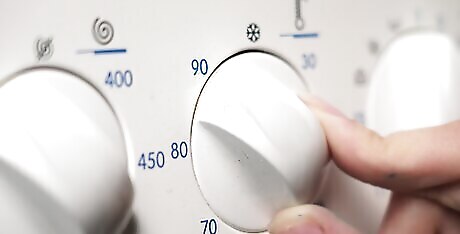
Use the hottest water that’s safe for your clothes on their care label. Hot water helps prevent white clothes from fading and is more effective at killing germs and bacteria than cool water. Just check your clothes’ care label to see what temperature water is recommended for washing them, as hot water is safe for some fabrics but can shrink or damage others. In general, delicate garments require cooler water while sturdier items like jeans, cotton clothes, towels, and linens can handle hotter water. Hot water is generally not recommended for nylon, spandex, lycra, and certain cotton blends, as it can cause them to shrink or become misshapen. It’s best to wash heavily used and soiled items, like linens and towels, in hot water.
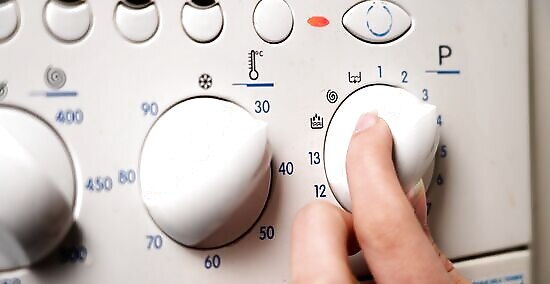
Select a washing cycle based on your clothes’ fabric type. Most washing machines have several washing cycles, like Normal, Heavy, and Delicate or Gentle. Simply look at the care labels on your clothes to determine what cycle is best for your load. For instance, you typically wash delicate fabrics, like silk, on a Gentle cycle and sturdier fabrics, like towels, on a Normal or Heavy Wash cycle. Your clothes’ soil level also impacts the cycle you choose. Choose a delicate or normal cycle if your clothes aren’t very soiled and a heavy cycle if they are.
Add a whitening laundry detergent and start your washing machine. Choose a laundry detergent that contains whitening agents to brighten your clothes, like enzymes, OxiClean, or bleach. Just follow the product’s instructions to add the recommended amount of detergent for the size of the load you’re washing.Tip: Instead of adding fabric softener to your load, cleaning expert Susan Stocker recommends adding “a cup (237 ml) of vinegar in your wash.” White vinegar “is a natural, amazing deodorizer” that can also soften your clothes.
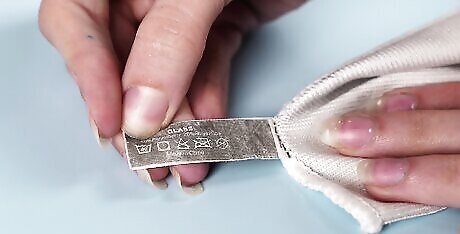
Dry your clothes on low to medium heat, depending on the care label. As soon as your clothes are done in the wash, transfer them to the dryer. Just check the care labels on your garments to see what dryer temperature is recommended. Some items might be air dry only. In general, stick to low or medium heat when drying white clothes. Using high heat and overdrying your garments can cause them to fade or yellow. Alternatively, air dry all of your clothes outside. The sun helps brighten white clothes and kill bacteria while the breeze gives your clothes a fresh scent. Note: Check your clothes for any stains before drying them, as heat can set the stain. Treat any remaining spots with stain remover and wash them again.
Sorting and Separating White Clothes
Separate your white clothes from clothes with any colors on them. Cleaning expert Susan Stocker says the best way to wash white clothes is to “only wash white with white.” Sorting your white clothes from dark and bright colored clothes prevents the colors from transferring to your white items and staining them. Tip: Susan Stocker says “don’t even risk washing beige with white” clothes, as even lightly colored garments can “discolor your white fabrics.”
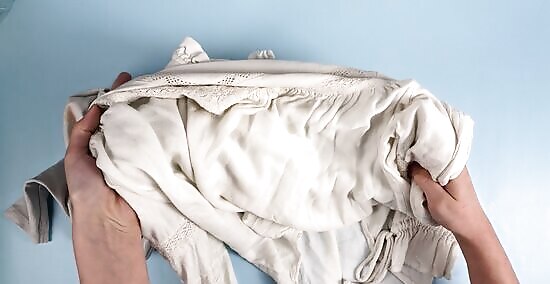
Sort your whites by fabric type and washing temperature. Different fabric types require different water temperatures to get them clean safely. Put all of your sturdy fabrics, towels, jeans, cottons, linens, and clothes containing manmade fibers into one pile. Then, put all your delicate fabrics, like silk, lingerie, Spandex, and activewear, into a different pile. You typically wash delicate fabrics in cool to warm water and sturdy fabrics in warm to hot water. Sorting your fabrics this way allows you to wash your clothes at the hottest temperature they can tolerate without being damaged. Some delicate items are labeled as hand-wash only. Hand washing your white items is an effective way to get them clean and keep them white. Fabric type also determines what laundry setting to wash your clothes on. You generally wash sturdy fabrics on Normal, Quick Wash, or Heavy (if they’re heavily soiled) and delicate fabrics on Delicate or Hand Wash.Tip: If you aren’t sure how to sort an item, check its care tag. Tags and clothing labels provide washing instructions for water temperature, washing cycle, and whether or not you can use bleach.
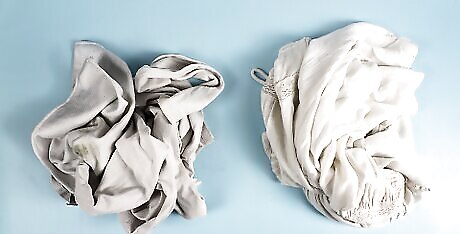
Divide your sorted whites into additional piles based on soil level. Place heavily soiled clothes into one pile, moderately dirty clothes into a second pile, and relatively clean clothes into a third pile. This prevents dirt, food, and other debris from staining your other white clothes and causing them to look dull or dingy. For example, if a white shirt is caked with mud after spending an afternoon gardening, separate that particular shirt from cleaner, brighter-looking whites.
Treating Stains and Brightening White Clothes
Get rid of yellow stains with baking soda or white vinegar. To get rid of armpit stains and other yellowing spots, cleaning expert Susan Stocker says to “mix 4 tbsp (68 g) of baking soda” with “1 quart (1 l) of warm water.” Scrub the stained spot with a toothbrush and “let it sit for 1-2 hours.” Or, “mix 50% vinegar” with “50% room temperature water,” scrub the stain, and “let it sit for 1-2 hours.” Stocker says to “rinse and check to see if the stain is completely removed” after letting the baking soda or vinegar sit. If the stain is gone, “wash as normal.” If not, repeat the steps until the stain is gone.
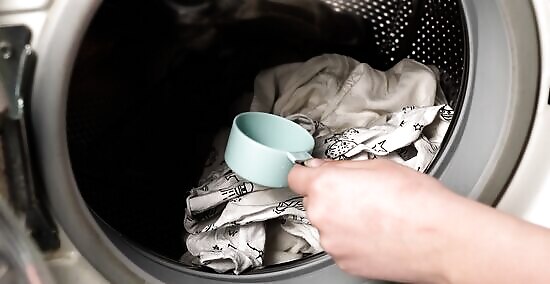
Brighten your white clothes with lemon juice. The citric acid in lemon juice naturally whitens and brightens your white clothes. Simply squeeze 1 cup (237 ml) of lemon juice and pour it into your washing machine’s bleach compartment, or add it directly into the drum. Then, add your laundry detergent as normal and start the wash. Alternatively, cut 2 lemons into thin slices and boil them in a large pot of water. Remove the pot from heat and add in your dull or stained clothes. Let them soak for 1 hour and then wash them. Lemon juice can bleach colored clothes, so only use it to brighten white garments.
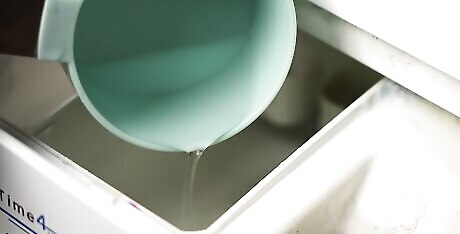
Whiten dull and dingy white clothes with hydrogen peroxide. Hydrogen peroxide is a natural bleaching agent that removes dark stains, like blood and ink, and brightens your clothes. Simply add 1 cup (237 ml) of hydrogen peroxide into your laundry machine’s bleach compartment, or pour it directly into the drum. Then, add laundry detergent and wash your clothes as normal. To treat small stains, dab the spots with hydrogen peroxide and a white cloth. Let the peroxide soak for a few minutes, then wash your clothes. Hydrogen peroxide also kills germs and deodorizes your clothes.
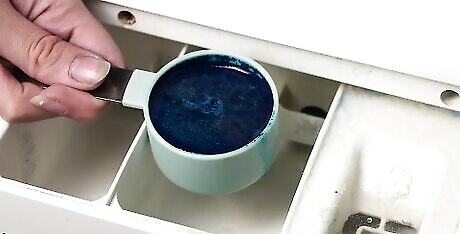
Make your whites look whiter with a bluing agent. A bluing agent is a special liquid made with a blue dye that helps brighten and whiten your white clothes. Simply add bluing agent directly to your laundry load along with laundry detergent. Just follow the manufacturer’s instructions on the back of the bottle to add the correct amount of bluing agent to your load. The agent is typically removed during the rinse cycle, so you don’t have to worry about it after you add it to the wash.
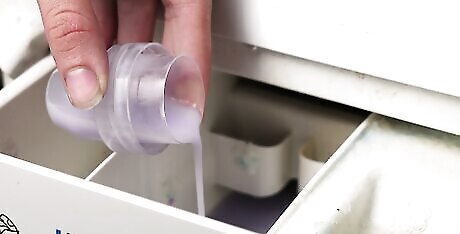
Brighten your laundry load with a whitening laundry booster. Commercial laundry boosters, like Tide Brights and Whites Rescue In-Wash Laundry Booster, are made to brighten your white clothes as you wash them. Simply add the booster to your laundry machine, pour in your laundry detergent, and start your machine. Follow the manufacturer’s instructions on the back of the booster to know how much to add for your load size.

Bleach your white clothes with oxygen bleach. Oxygen bleach is gentler than chlorine bleach while still lifting stains and brightening your clothes. Read the manufacturer’s instructions on the back of the bleach bottle and measure out the correct amount of bleach for your load size. Then, pour it into your machine’s bleach dispenser or let the drum fill with water and then pour in the bleach. Add laundry detergent and then start the warmest water cycle that’s safe for your clothes. Dry your clothes as normal after washing them. Check your garment’s care label to make sure it's safe to bleach: A hollow triangle means you can use any bleach on the item. A triangle filled with diagonal lines means only use non-chlorine bleach. A solid black triangle with lines means you can’t bleach the item. Chlorine bleach isn’t typically recommended for white clothes, especially if they’re not cotton-based. Using too much chlorine bleach can yellow and discolor your white clothes. Warning: Wear a respirator mask and gloves when using bleach, as it can produce harsh fumes and hurt your skin. Do not mix bleach with any other cleaners, as it can produce a toxic gas.
Keeping Your White Clothes from Fading
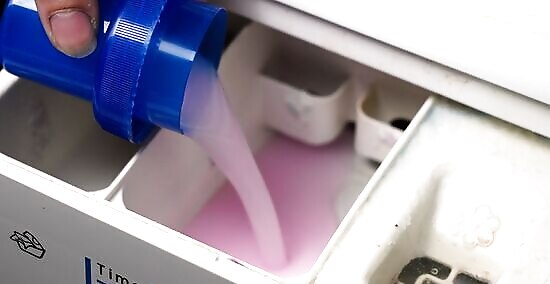
Use the recommended amount of detergent for your load size. Use the laundry detergent cap to add the precise amount of detergent for your load size based on the manufacturer’s instructions. Using more detergent than you need can lead to soapy buildup on your clothes that attracts more dirt and causes them to look dull and dingy. The amount of detergent you use depends on the laundry load size and the strength of your detergent. Don’t use too little detergent to wash your clothes either, as your clothes might not get clean. Follow the manufacturer’s instructions as closely as possible.
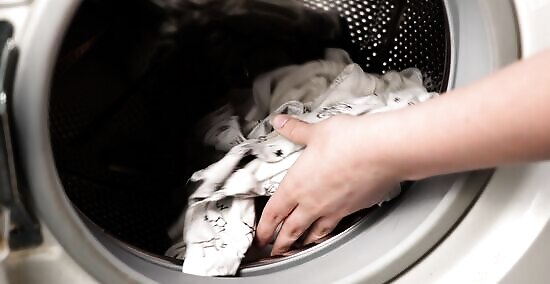
Leave space in your machine’s drum when you wash clothes. Don’t overfill your machine if you have a large load of laundry. Overfilling or tightly packing clothes in your machine means less water and detergent can circulate around your clothes. This can leave your whites less clean and cause them to look dingy.

Clean your laundry machine about once per month. A dirty laundry machine can cause your clothes to smell and leave your whites looking dull. About once per month, wash your machine by running an empty cycle using the hottest water possible and add 2 cups (473 ml) of white vinegar. If you use your laundry machine less often, deep clean it about every other month.
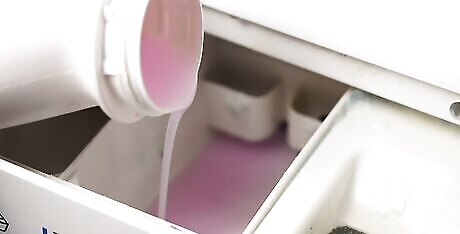
Add more laundry detergent if you have hard water. Hard, mineral-rich water can make your detergent less effective, leaving a soapy buildup that makes your white clothes look dingy and dull. To counteract hard water, simply add a bit more detergent to your loads. Or, use a laundry detergent with a lower pH level. Alternatively, buy a water-softening treatment system for your home. While this is a more expensive option, this removes the excess minerals in your hard water so all the water in your home is soft.



















Comments
0 comment